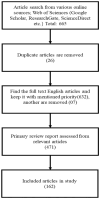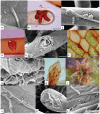Reviewing bryophyte-microorganism association: insights into environmental optimization
- PMID: 38946907
- PMCID: PMC11211263
- DOI: 10.3389/fmicb.2024.1407391
Reviewing bryophyte-microorganism association: insights into environmental optimization
Abstract
Bryophytes, the second-largest group of plants, play a crucial role as early colonizers of land and are a prolific source of naturally occurring substances with significant economic potential. Microorganisms, particularly bacteria, cyanobacteria, fungi form intricate associations with plants, notably bryophytes, contributing to the ecological functioning of terrestrial ecosystems and sometimes it gives negative impact also. This review elucidates the pivotal role of endophytic bacteria in promoting plant growth, facilitating nutrient cycling, and enhancing environmental health. It comprehensively explores the diversity and ecological significance of fungal and bacterial endophytes across various ecosystems. Furthermore, it highlights the moss nitrogen dynamics observed in select moss species. Throughout the review, emphasis is placed on the symbiotic interdependence between bryophytes and microorganisms, offering foundational insights for future research endeavors. By shedding light on the intricate bryophyte-microorganism associations, this study advances our understanding of the complex interplay between plants, microbes, and their environment, paving the way for further research and applications in environmental and biotechnological realms.
Keywords: bacterial and fungal endophytes; bryophyte; microorganism; nitrogen dynamics; symbiotic association.
Copyright © 2024 Dangar, Chavada, Bhatt and Raviya.
Conflict of interest statement
The authors declare that the research was conducted in the absence of any commercial or financial relationships that could be construed as a potential conflict of interest.
Figures




Similar articles
-
Bacterial-biota dynamics of eight bryophyte species from different ecosystems.Saudi J Biol Sci. 2015 Mar;22(2):204-10. doi: 10.1016/j.sjbs.2014.07.009. Epub 2014 Aug 2. Saudi J Biol Sci. 2015. PMID: 25737654 Free PMC article.
-
[Endophytic fungal diversity of four bryophyte species in Dawei Mountain, Southwest of China].Wei Sheng Wu Xue Bao. 2015 Jun 4;55(6):764-71. Wei Sheng Wu Xue Bao. 2015. PMID: 26563002 Chinese.
-
Current Scenario and Future Prospects of Endophytic Microbes: Promising Candidates for Abiotic and Biotic Stress Management for Agricultural and Environmental Sustainability.Microb Ecol. 2023 Oct;86(3):1455-1486. doi: 10.1007/s00248-023-02190-1. Epub 2023 Mar 14. Microb Ecol. 2023. PMID: 36917283 Free PMC article. Review.
-
Root endophytic Penicillium promotes growth of Antarctic vascular plants by enhancing nitrogen mineralization.Extremophiles. 2020 Sep;24(5):721-732. doi: 10.1007/s00792-020-01189-7. Epub 2020 Jul 22. Extremophiles. 2020. PMID: 32699913
-
Insights into taxonomic diversity and bioprospecting potential of Cerrado endophytic fungi: a review exploring an unique Brazilian biome and methodological limitations.World J Microbiol Biotechnol. 2022 Aug 24;38(11):202. doi: 10.1007/s11274-022-03386-2. World J Microbiol Biotechnol. 2022. PMID: 35999403 Review.
References
-
- Ackermann K., Zackrisson O., Rousk J., Jones D. L., DeLuca T. H. (2012). N2 fixation in feather mosses is a sensitive indicator of N deposition in boreal forests. Ecosystems 15, 986–998. 10.1007/s10021-012-9562-y - DOI
-
- Alam A. P., Saumya P., Shivangi P., Alam A. (2019). 16S rRNA sequence-based analysis of bacterial communities associated with the selected mosses of Mount Abu (Rajasthan), India. BIJ 3, 230–233. 10.15406/bij.2019.03.00149 - DOI
Publication types
LinkOut - more resources
Full Text Sources

